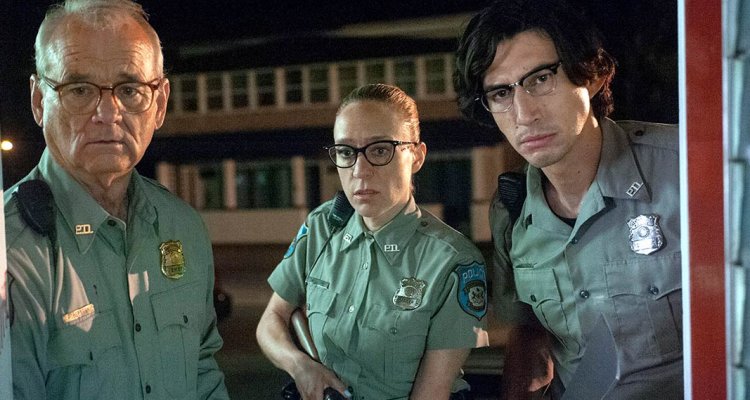Prison breaks, a postmodern Western, hip-hop samurai, stoner rock vampires, the omnibus film—if it’s a genre, then Jim Jarmusch has probably put his unique stamp on it. Each time the American original tangles with a new form–particularly those that are experiencing a moment in the pop-cultural sun–he holds to the stylistic signatures that have defined his work since indie classic “Strange in Paradise.” With “The Dead Don’t Die”—the opening film of this year’s Cannes Film Festival, also in the running for the Palme d’Or—Jarmusch runs in a completely different direction and tackles the zombie film through a fourth-wall-breaking, bluntly comedic lens. It’s an approach that is likely to gain the filmmaker more mainstream eyeballs, but the ho-hum execution is sure to turn away diehard fans, worried that creative rigor mortis has set in.
READ MORE: 2019 Cannes Film Festival: The 21 Most Anticipated Movies
“The Dead Don’t Die” invests a great deal of its run time in setting the table for a zombie apocalypse, which finds its epicenter in the nondescript middle American town of Centreville. This community is unmistakably rooted in the political present. Before the first act is over, the film checks off references to MAGA, gender identity, and climate-change deniers—and it’s the last of these that can be blamed for the rise of the living dead, as well other harbingers of doom. The clumsy references to our current times make for surprisingly broad humor for a director whose comedic work is best described to arthouse neophytes as an acquired taste.
READ MORE: the 100 Most Anticipated Films Of 2019
On the front lines are Police Chief Cliff Robertson (Bill Murray) and Officer Ronnie Peterson (Adam Driver, Jarmusch’s new muse following “Paterson“). As a duo, they drive the film well as luminaries of Jarmusch’s star system, with the younger performer effortlessly matching Murray’s iconic cadence. Centreville is populated with many other familiar faces, both above and below the ground, with some new to the director’s sphere: Chloë Sevigny, Steve Buscemi, Danny Glover, Selena Gomez, Caleb Landry Jones, Iggy Pop, and, of course, Tom Waits as the local hermit, among others and all-in performances of variable screen time. None, however, are afforded all that much depth.
READ MORE: The 25 Best Films Of 2019 We’ve Already Seen
The most disappointing of the film’s star-studded cast is undoubtedly Tilda Swinton as katana-wielding Scottish undertaker Zelda Winston. The actress is chewing scenery with the over-the-top characterization, but including in the utterly random grab bag of tropes is another case of cultural appropriation, so soon after her controversial part of The Ancient One in “Doctor Strange” (and a wound all the fresher because of “Avengers: Endgame.”) Worse, Jarmusch has already gone to this well with “Ghost Dog: The Way of the Samurai,” and to much greater success.
READ MORE: Summer Movie Preview: 35 Films You Shouldn’t Miss
But how about the zombies themselves? The makeup work on the undead may not reinvent the wheel, but the practical effects nonetheless scratch the squelchy itch that the genre demands. External to the inciting incident for his night of the living dead, Jarmusch adds his own flourishes to the mythology. The creatures, rather than screaming for brains (or not at all, depending on your zombie canon) skip their record on something they craved in life, and these vocalized obsessions garner “The Dead Don’t Die” its biggest laughs. The other twist is less successful; rather than arterial spray, the zombies’ severed appendages produce clouds of dust. While unexpected, the effect lacks polish and draws an unflattering comparison to the dusted vamps from “Buffy the Vampire Slayer.”
Among the memorabilia at the local gas station is a Mondo poster of the OG “Night of the Living Dead,” an Easter egg that makes for a pretty apt read on the engagement of “The Dead Don’t Die” with zombie culture. The film is a loving homage to the George Romero classic, to be sure, but one that’s aimed as much at hip cinephiles as well as the masses. Like its antecedents, Jarmusch’s entry asks its audience to sift through entrails and rended flesh for profound commentary on modern society. The gore is fetishized and amplified, and only one part of the director’s often irritating insistence on repetition. Not only does Jarmusch double up on grisly close-ups of mutilated corpses, but also corny jokes and, most gratingly, Sturgill Simpson‘s on-the-nose country ‘theme song’ with which “The Dead Don’t Die” shares its title.
In its most compelling moments, “The Dead Don’t Die” is an antidote to the bloated pathos of post-“Walking Dead” zombie fiction. Don’t expect a television season’s worth of grieving here; the surviving denizens of Centreville have no qualms dispatching the reanimated corpses of their loved ones. Supporting characters are introduced only to arrive at a narrative dead end; it would be a stretch to even consider them fodder in the conventional horror-film meaning of the word. And yet, a superficial course correction to the stale zombie formula isn’t enough to justify Jarmusch’s genre flexing in “The Dead Don’t Die,” which is uncharacteristically sloppy. As a film, it shuffles around, shouting out the one thing it’s desperate for: ‘Purpose!’ [C]

